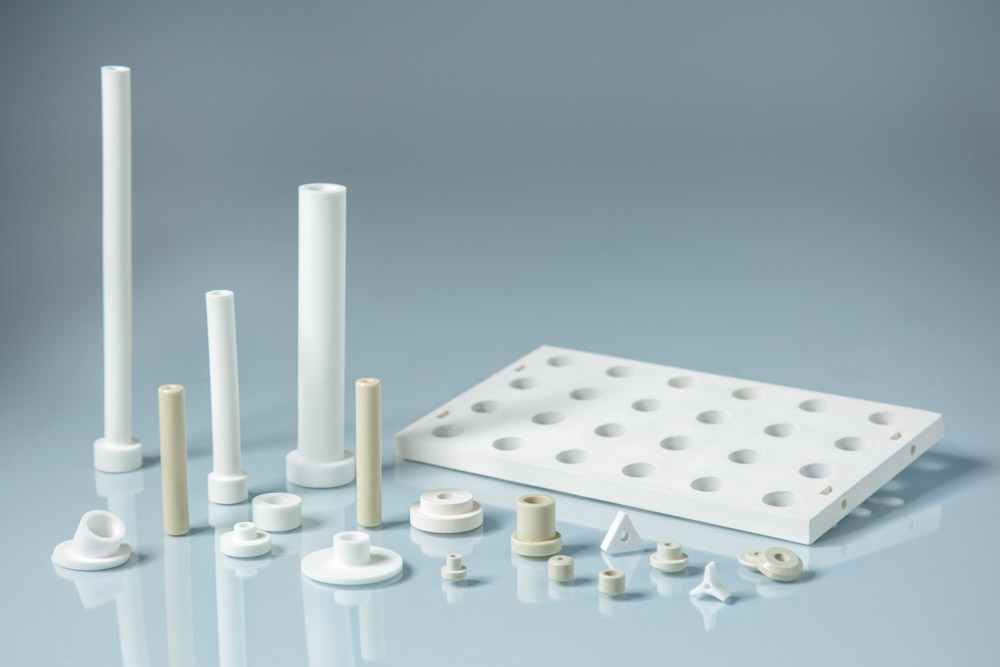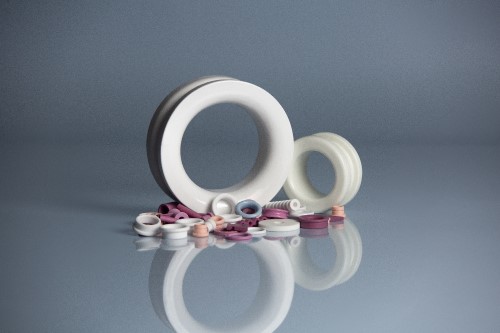- BY Matt Kroll
- POSTED IN Advanced Ceramics
- WITH 0 COMMENTS
- PERMALINK
- STANDARD POST TYPE
Ceramic Machining Process
Ceramic machining is the process of shaping and forming ceramic materials into desired shapes and dimensions using techniques such as grinding, turning, milling, drilling, and electrical discharge machining (EDM). These techniques allow for precise shaping and specific surface finishes in ceramics. Ceramic materials possess unique properties like high hardness, heat resistance, electrical insulation, and chemical stability, making them highly valuable in various industries. The importance of ceramic machining lies in its role in producing intricate ceramic components used in electronics, aerospace, automotive, medical devices, and other sectors. Whether it's ceramic substrates for electronic circuits or components for turbine engines, ceramic machining ensures the precise fabrication of these critical parts.
This blog aims to provide readers with information regarding the common challenges faced in machining ceramics, how these challenges can be overcome, various ceramic machining techniques, factors affecting ceramic machining, and surface finishing and quality control techniques used to improve ceramic machining. By delving into the intricacies of ceramic machining, readers will gain insights into the importance of this process and its relevance in creating high-performance ceramic components.
Common Challenges Faced in Machining Ceramics
Machining ceramics presents several common challenges. Ceramics' exceptional hardness resists wear but makes them difficult to machine, leading to increased tool wear and difficulty maintaining tool life and dimensional accuracy. Additionally, ceramics' brittleness makes them prone to fracture or chipping under stress, posing a risk of catastrophic failure during machining. Low thermal conductivity in ceramics hampers heat dissipation, resulting in excessive heat buildup that affects tool life, surface quality, and dimensional accuracy. Furthermore, achieving desired surface finishes is challenging due to ceramics' brittleness, which makes them susceptible to microcracks, surface roughness, and residual stresses.
Solutions and Approaches to Overcome Challenges
Innovative approaches and solutions have been developed to overcome the challenges of machining ceramics. These include using advanced tooling materials such as cutting tools with diamond coatings or ceramic-based materials, which offer superior hardness, wear resistance, and thermal stability. Additionally, careful optimization of cutting parameters such as speed, feed rate, and depth of cut helps minimize tool wear, reduce heat generation, and improve surface quality. Coolant or lubricant during ceramic machining aids in heat dissipation and friction reduction, enhancing tool life and minimizing thermal damage. Implementing vibration damping techniques and ensuring machine tool stability minimize vibrations and the risk of workpiece damage, particularly in high-speed operations. Furthermore, post-machining treatments like thermal stress relieving and surface polishing help mitigate residual stresses and improve surface finish.
Ceramic Machining Techniques
There are various types of ceramic machining techniques, each with their own applications and limitations, including:
Grinding
Grinding is a widely used ceramic machining technique involving abrasive particles to remove material from the ceramic surface. It utilizes grinding wheels or belts to achieve precise shaping and surface finishing. Grinding is suitable for both large-scale material removal and achieving tight tolerances. It offers versatility regarding the range of ceramics it can work with and provides excellent control over surface quality. However, grinding ceramics can be challenging due to the high hardness and brittleness of the materials, which necessitate careful selection of grinding parameters and tooling to prevent damage or fracture.
Turning
Turning is a ceramic machining technique that involves the rotation of a ceramic workpiece while a cutting tool removes material. It is commonly used for cylindrical components such as tubes and shafts. Ceramic turning requires specialized tools with high cutting-edge strength and wear resistance. Cutting speed, feed rate, and tool geometry significantly impact turning performance. The process enables efficient material removal and good dimensional accuracy. Still, careful consideration must be given to tool selection, tool life management, and controlling the generated heat to avoid thermal damage.
Milling
Milling is a ceramic machining technique that uses rotating cutting tools to remove material from the ceramic workpiece. It is suitable for producing complex shapes, pockets, and slots. Different milling techniques, such as the face, peripheral, and end milling, are employed based on the desired outcome. Milling ceramics requires robust tooling with high hardness and toughness. Feed rate, cutting speed, and tool geometry influence milling efficiency and surface finish. However, ceramics' inherent hardness and brittleness can pose challenges, such as tool wear and the potential for surface damage, necessitating careful tool selection and process optimization.
Drilling
Drilling is a ceramic machining technique that involves the creation of holes in ceramic materials using specialized drills. It is suitable for producing precise and accurate holes in various applications such as mounting hardware, electrical connections, or fluid passages. Drilling allows for the formation of holes with different dimensions and orientations to meet specific design requirements. The process requires the use of robust drills designed for the hardness and brittleness of ceramics, often made of diamond or carbide. Factors such as drilling speed, feed rate, and coolant/lubricant usage influence the process. Drilling ceramics can be challenging due to the material's tendency to crack or chip. Controlling drilling parameters such as feed rate, drill speed, and coolant/lubricant usage is crucial to minimize the risk of thermal damage and achieve accurate hole dimensions. By considering these factors, drilling enables the creation of precise holes in ceramic materials for various applications.
Electrical Discharge Machining (EDM)
Electrical discharge machining (EDM) is a non-contact ceramic machining technique that uses electrical discharges to remove material from the workpiece. EDM is particularly useful for machining complex and intricate shapes in ceramics with high precision. It offers the advantage of working with hard and brittle ceramics without applying mechanical forces. However, EDM has slower material removal rates compared to other techniques, and the process can leave a recast layer on the machined surface. EDM requires careful consideration of parameters such as discharge energy, electrode material, and dielectric fluid selection to achieve the desired machining outcomes.
Factors Influencing Ceramic Machining
There are several important factors influencing one’s choice when performing ceramic machining, such as:
Material Properties
The properties of the ceramic material being machined play a crucial role in the machining process. Hardness, brittleness, thermal conductivity, and chemical stability affect tool selection, cutting strategies, and overall machining performance.
Tooling Considerations
The selection of appropriate cutting tools is essential in ceramic machining. Factors like tool material, geometry, edge preparation, and coatings impact tool life, cutting forces, and surface finish. Choosing tools specifically designed for ceramic machining helps optimize performance and minimize tool wear.
Cutting Parameters
Optimizing cutting parameters such as cutting speed, feed rate, and depth of cut is critical in ceramic machining. These parameters influence material removal rate, tool wear, heat generation, and surface quality. Finding the right balance is crucial to achieve efficient and accurate machining results.
Coolant and Lubrication
Coolant or lubricant is vital in ceramic machining to dissipate heat, reduce friction, and improve tool life. The selection and application of appropriate coolant/lubricant and strategies for effective delivery and control contribute to better heat management and enhanced machining performance.
Machine Setup and Vibration Control
Machine setup and stability are important factors in ceramic machining. Ensuring proper alignment, rigidity, and damping of the machine tool helps minimize vibrations and maintain precision during machining. Effective vibration control techniques prevent workpiece damage and ensure consistent and accurate machining results.
Considering these factors in ceramic machining enables manufacturers to optimize the process, improve productivity, enhance surface quality, and achieve dimensional accuracy. Understanding and controlling these influences are vital to successful and efficient ceramic machining operations.
Surface Finishing and Quality Control
Surface finishing plays a crucial role in ceramic machining as it directly impacts the final product's functionality, aesthetics, and overall quality. Achieving the desired surface finish is important for improving component performance, ensuring proper fit and assembly, and
enhancing the durability and reliability of ceramic parts.
Several techniques are employed in ceramic machining to achieve the desired surface finish. These include precision grinding, polishing, lapping, honing, and abrasive blasting. Each technique is selected based on the specific requirements of the ceramic material and the desired surface characteristics, such as smoothness, flatness, and roughness.
Quality control measures and inspection methods are implemented to ensure the quality and consistency of ceramic components. These may include dimensional measurement using coordinate measuring machines (CMM), surface roughness measurement, visual inspection for defects, and non-destructive testing techniques like ultrasonic or X-ray inspection. Quality control helps identify any deviations or defects in the surface finish and ensures that the final product meets the required specifications and standards.
Conclusion
Ceramic machining is a complex process with unique challenges due to the hardness, brittleness, low thermal conductivity, and surface integrity of ceramics. Innovative approaches, including advanced tooling, optimized parameters, coolant/lubrication, and vibration control, overcome these challenges. Techniques like grinding, turning, milling, drilling, and EDM offer precision shaping. Factors affecting ceramic machining include material properties, tooling, parameters, coolant/lubrication, and vibration control. Achieving the desired surface finish and implementing quality control ensures high-quality ceramic components with efficiency and performance.


